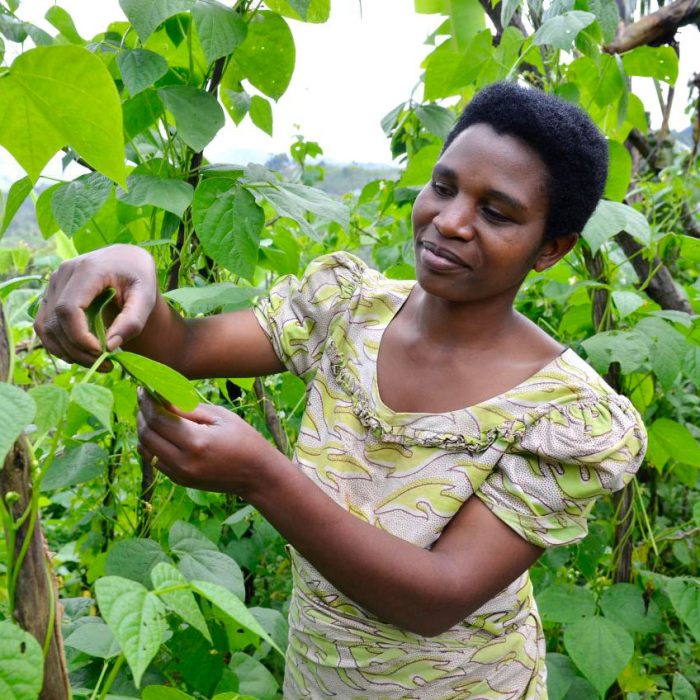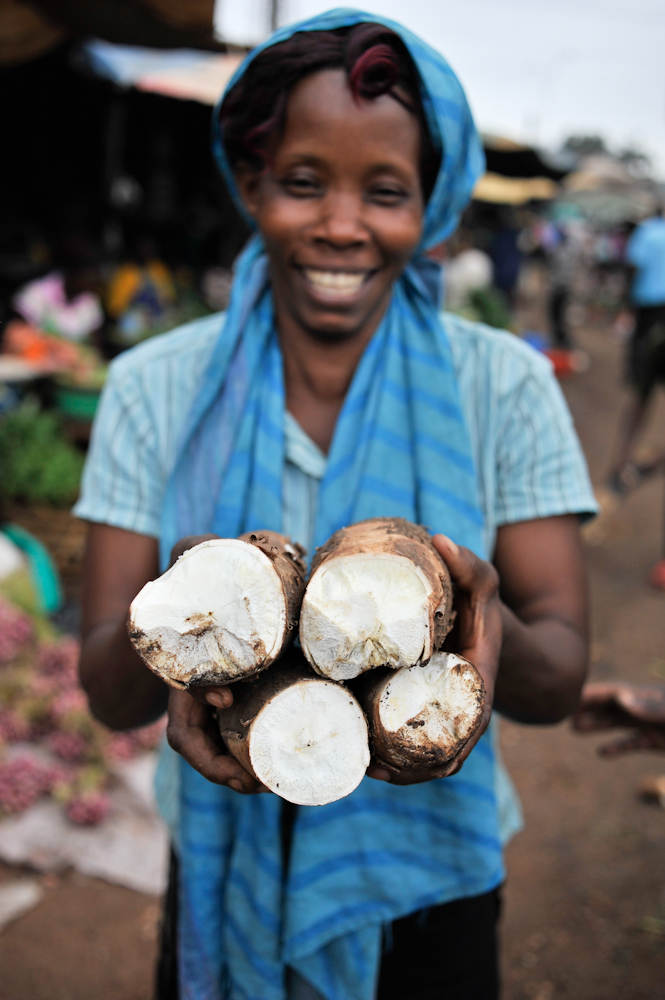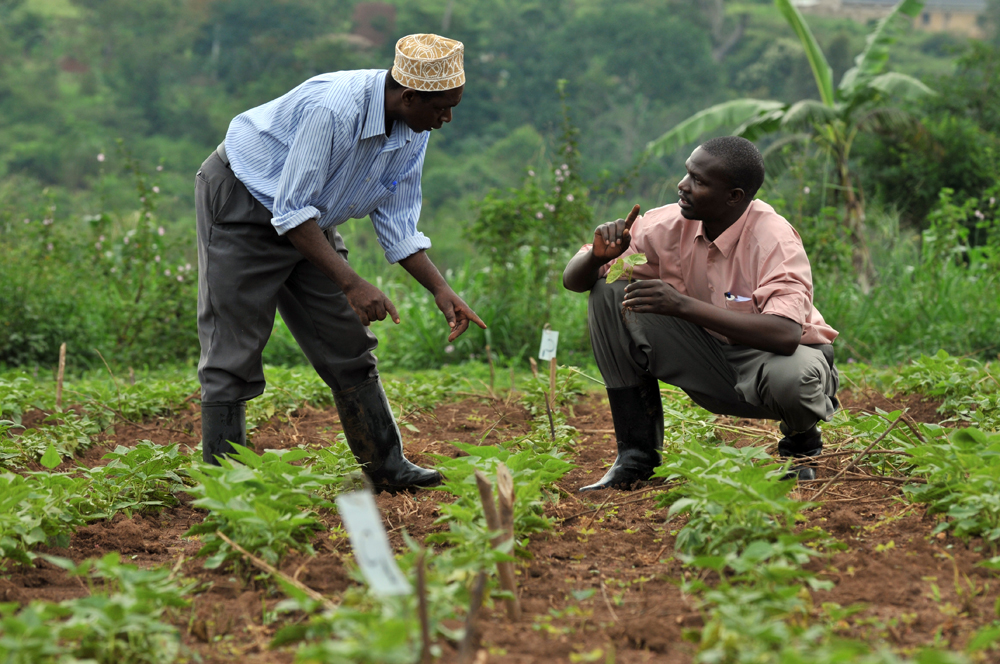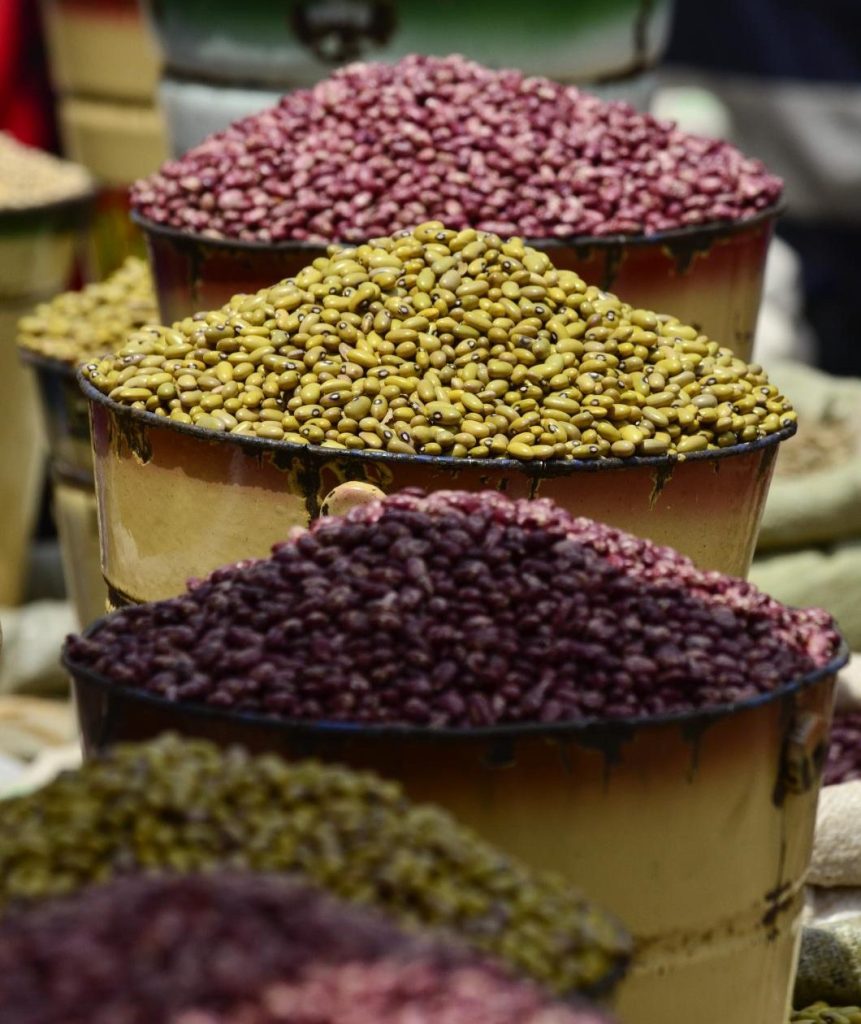Data collection
Building on the tricot methodology of helping farmers identify crop varieties and technologies most suited to their conditions, this activity focuses on standardizing and expanding the types of data collected on-farm. This includes farmer-led yield estimation, with wider use of mobile phone-based phenotyping and image analysis of traits and soil characteristics across CGIAR crops.
Standardized protocols are being developed to sample a diverse range of farmers, consumers and other stakeholders, and to learn from farmer interactions.
These data collection methods will be tested in ongoing CGIAR tricot partnerships under at least three other Bill & Melinda Gates Foundation-funded CGIAR projects focused on cowpea, cassava, beans and maize. Standard operating procedures will be developed and published for both farmer and consumer testing (including processing traits).
The project will build on ongoing and planned financial analyses and cost–benefit analyses of on-farm trial (OFT) methods. One aim is to determine the cost per data point. This is a compelling way of documenting the value add of OFTs through expanded on-farm evaluations in late-stage variety evaluations. It will also assist NARES partners in making informed decisions on resource allocation. This activity is led by IITA.

Variety performance analysis
This activity will improve statistical methods for the analysis of on-farm trials (OFTs). It will create a spatial sampling tool to optimize the location of trials based on the environmental heterogeneity of Target Population Environments while minimizing travel costs.
It will develop new methods to analyze the joint effects of genotype, environment, crop management and gender/socio-economic factors using OFT data by combining crop models and statistics. Lastly, it will develop new ways to assess on-farm realized genetic gain and socio-economic gain, feeding into investment cases for breeding pipelines.
Initial analyses of genotype, environment and management (GxExM) interactions will be developed with existing and simulated data, accumulated over seasons to aggregate data and ‘borrow statistical strength’. Sampling and sample size strategies will aim to involve partners in agreeing on the required approach – aiming to increase external validity, hence representing the range of farming environments, rather than increasing discriminative power for certain traits, for example.
Tools will be incorporated into subsequent activities to strengthen the feedback loop from OFTs to breeding product management. This activity will mainly develop analyses on cowpea, beans, cassava and maize, and is led by Wageningen University (Biometris and Plant Production Systems).
Inform product management
This activity focuses on ensuring that tricot on-farm trial (OFT) insights are considered in product advancement and commercialization decisions. To create the optimal conditions for this, standardized summary reports will be used to inform product advancement meetings, variety release and commercialization, and seed marketing investments.
1000FARMS will engage with variety release committees through distribution of unreleased germplasm and information to pave the way for submissions supported by tricot trials. 1000FARMS report formats will be designed with key researchers engaged in the Genetic Innovation Action Area of OneCGIAR, to be incorporated into the ClimMob platform, which will automatically generate reports on demand.
The aim is for reports to support decision-making and prioritization with standardized information on field performance and farmers’ preferences, paying close attention to climate adaptation and gender.
This activity will also engage with NARES and CGIAR actors managing and governing breeding product design and management to promote increased investment in and appropriate standards for OFTs. This will include the initiatives of the OneCGIAR Genetic Innovation Action Area (Breeding, Market Intelligence, Seed Systems), the CGIAR-NARES breeding programs/networks, the BPAT project, national variety release committees and seed companies/traders.

ClimMob platform integration
This activity will focus on ClimMob’s interoperability, linking the platform fully to existing breeding databases/systems through the Breeding API (BrAPI) project and an appropriate data model. This will make it possible to push data to these systems and publish data following FAIR guidelines.
The team will work with the BrAPI Community of Practice and the organizations developing/maintaining breeding software (EBS, BMS, BreedBase). This activity will also incorporate research outputs from other activities into the ClimMob platform, which will all require software development. There will be further improvement of the user interface through digital design.
The data will be collected into a data cube that will be accessible for interactive ‘slicing and dicing’ (using Scriptoria’s NIAD data analysis approach). This is one of several options that will be used, including data export to breeding databases (visualization of data through the means existing on those platforms); data export to use with R (ClimMob is a suite of tools, with several R packages for which training will be developed); and automated ClimMob reports (customizable outputs of R scripts).
Finally, the activity will enable monitoring and rewarding of the performance of field agents for successful completion of trial steps and return of high-quality data throughout the season. This activity is led by the Alliance of Bioversity International and CIAT.
1000FARMS course
This capacity-building activity will contribute to the creation of a pool of African professionals skilled in implementing on-farm trials (OFTs) following the 1000FARMS approach, leading to high-quality data and increased understanding of variety performance in use environments. During the first phase, the course will focus on professionals working in CGIAR-NARES breeding networks, and later will also be offered to African graduates. The course is being designed in collaboration with the Demand-Led Breeding Community of Practice (hosted by the Alliance) which brings together African centers of excellence in breeding education (ACCI, WACCI, MaRCCI, University of Nairobi).
The course will be a pre-condition for organizational funding and will provide different levels of training for trial implementers, field agents, breeders and data scientists, as well as on-demand support. On completion of the course, participants can join the 1000FARMS Community of Practice for peer-to-peer exchange of experiences, professional advice, the latest innovations in 1000FARMS, grant opportunities, and support materials.
This aims to increase the overall professional engagement, confidence and drive for improvement and innovation of those who become part of the 1000FARMS community and stimulate constant communication and collaboration between professionals from different organizations.

Field implementation
CGIAR-NARES breeding network organizations will be provided with targeted additional support to implement the 1000FARMS approach. This will be a mix of single-crop-focused networks and nascent multi-crop networks. The activity will work with ongoing CGIAR projects that have clearly committed to expanding implementation of tricot and on-farm trials (OFTs) (NextGen Cassava, AGGMW, SPTA, AVISA).
Technical backstopping and modest budgetary support will be provided to work with a new partner (private or public) whose participation in 1000FARMS is likely to have multiple benefits for the entire CGIAR breeding network, and to run small pilots within large organizations.
Also, these packages of support will be used to encourage NARES to pilot new collaborative OFT arrangements with other organizations that can scale OFTs using their current pool of field agents.
Progress will be digitally monitored with the ClimMob platform, triggering payments. After Year 2, the project will introduce the annual Innovation Grant Award, which will provide small awards ($50–$100) to recognize individuals in the CGIAR-NARES breeding networks who have successfully used their Innovation Grants to bring about a genuine innovation, cost saving or time/efficiency improvement to the 1000FARMS model.
Conduct scoping of multi-crop on-farm trial networks
This activity will involve an in-depth scoping study of current practices and potential around multi-crop on-farm trial (OFT) networks, starting in Uganda. The scoping study will build a baseline for multi-crop OFT networks in terms of potential return on investment, capacity, and the regulatory environment.
This will lead to insights into the potential for public‒private institutional arrangements, arrangements to share costs and data, and the possibilities of reaching economies of scale. The scoping model will be adapted to the Ugandan context.
The scoping exercise will also consider costs and benefits. Cost–benefit studies of the cost per data point of OFTs (being finalized by the CGIAR’s RTB project) will be repeated within 1000FARMS, following the RTB format in order to achieve maximum data comparability.
Available studies show that tricot can reduce costs per data point and provides data that more accurately predict adoption.

Establish multi-crop on-farm trial networks
This activity focuses on investing in multi-crop on-farm trial (OFT) networks that demonstrate the potential to scale OFTs. Following the scoping and feasibility exercise in Uganda, the project will set up a multi-crop OFT network in the country.
Investment will be limited to breeding networks that incorporate a multi-crop breeding focus, so as to encourage efficiencies and economies of scale, as well as consolidation of efforts and technologies across multiple breeding lines in contiguous geographies.
CGIAR-NARES breeding networks that demonstrate clear synergies with other breeding networks (either by crop or by geography) will be prioritized, especially if they are able to demonstrate upfront any cost or labor savings anticipated by the synergy.
Profits will serve further investment in the future. The activity’s investments will mobilize additional public and private investments and the team will actively engage stakeholders to achieve this.


